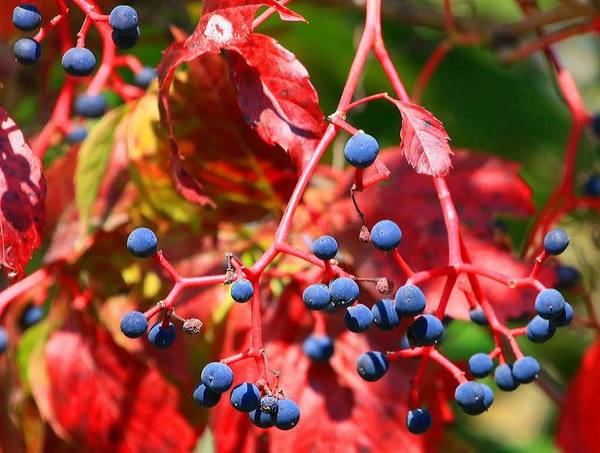
Girl's grape is a vivid representative of the Vinogradov family. Unlike ordinary grapes, it does not produce edible berries, and all its value lies in the decorativeness of the unusual form of foliage, which looks especially impressive in late autumn.
Content
general description
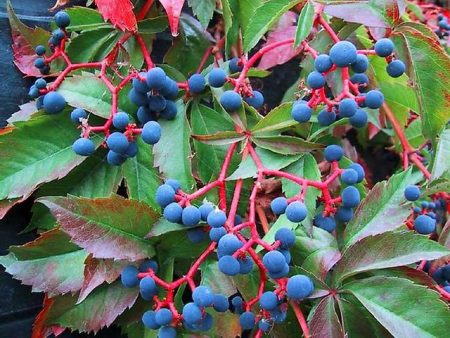
The botanical name of the girl’s grape is Parthenocissus, which translates as “virgin ivy”. This name is due to the biological characteristics of the plant: the structure of the leaf plate resembles ivy foliage. And the word "virgin" indicates the ability of flowers to form fruits and seeds without pollination. In nature, girl’s grapes are widely distributed in East Asia, North America and the Himalayas.
Gardeners call this grape “wild” for its extraordinary endurance, wild growth of shoots, winter hardiness, and unpretentiousness to growing conditions. All of these characteristics are akin to plants found in the wild.
Grapes are long flexible vines, the length of which can reach 25-30 meters. They can grow up, clinging to antennae, suckers to a vertical surface or spread along the ground, wrapping branches all objects that come across the path. At the same time, the branches have an extraordinary power of fastening - it is almost impossible to tear such a vine from a fence or a wall of a house with your hands. The annual shoots of green grapes are thin and flexible. With age, the shoots become woody, the bark acquires a golden color. Each shoot in summer is densely overgrown with large palmate foliage. It is three-, five- and seven-fingered. Grows on long stalks. In the warm season, the leaves are painted dark green. Some varieties have glossy leaves, others - matte, rough. By autumn, the color of the leaves changes to yellow, red and purple.
Leaves are the main decoration of girl's grapes.
Liana blooms in late June and blooms until mid-August. Inflorescences are small, unremarkable. They are difficult to notice against the background of large stellate leaves. In early autumn, flowers are replaced by pea fruits.
The fruits of the plant are small round berries. Their diameter is not more than 8 millimeters. Fruits on the branches are collected in small clusters of 10-12 pieces. Berry seeds can be used for seed propagation of grapes. The peel of the fruit is dense and thick. Depending on the variety, the color of the berry can be red, blue, burgundy or purple. In mature form, the color of the fruit is always unchanged - dark blue, almost black with a slight matte whitish bloom. The fruits are unsuitable for eating, as they contain a large amount of oxalic acid, which gives the berries bitterness and acid. Moreover, berries can cause serious poisoning.
Varieties of Girl's Grapes
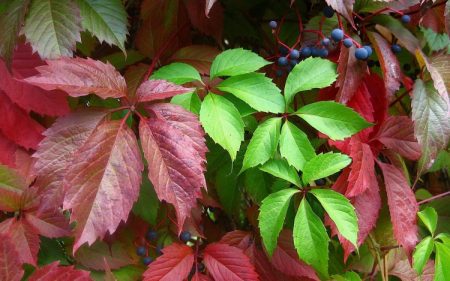
The genus of maiden grapes includes two large groups of plants: Asian and North American. Asian grapes include:
- five leafed;
- trefoil;
- univalent.
To North American:
- seven-leaved;
- five leafed.
These groups include several different varieties, which differ in shape and size of the leaf, the length of the vine, the requirements for growing conditions. Three types of grapes are known in Russia: “Five-leafed”, “Triostrenny”, “Attached”.They are most actively used in landscaping.
Five Leaf (Hungarian)
This grape is widely distributed in the east and in the central regions of North America. Five-leaf grapes are a fast-growing vine, the length of which can reach 20 meters. Branches grow by 2-2.5 meters per year. Shoots cling to a variety of surfaces with the help of branched antennae ending in a sticky suction cup. The leaf plate is pubescent; it is a brush of five dark green ovoid leaflets. The edges of the leaves are pointed, serrated. The back side of the sheet is painted in light green with a silver tint. Grapes blooms with small greenish flowers collected in loose inflorescences until late autumn.
Another name for the species is Virgin grapes.
In Russia, it is popular due to shade resistance and frost resistance. Winters without shelter even in the central regions.
The best varieties:
- Engelmannii
- Murorum.
- Troki.
- Yellow Wall.
Tripartite (ivy)
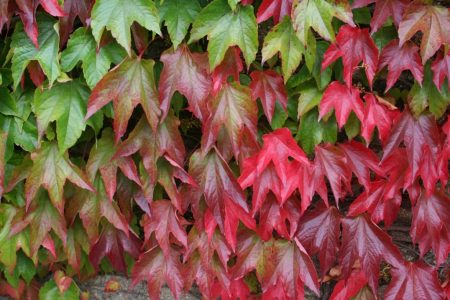
The homeland of this grape is China. The variety is especially popular in Korea, Japan and China. The Far Eastern liana grows to 15-20 meters in length. The leaves are three-fingered (but also non-fingered), up to 20 centimeters in diameter, with large pointed teeth. The color is dark green, glossy. The antennae of the shoots are equipped with rounded flattened extensions, with the help of which there is adhesion to the surface. The growing season is about 155 days. Flowering lasts about a month, from mid-June to early July. Grapes prefer fertile land, warm climate and long-term sunlight. It does not tolerate frost.
There are three varieties of ivy grapes:
- Viche grapes. The plant is overgrown with fine glossy foliage, which turns orange in autumn. The most common type.
- Golden grade. Originality to the plant gives green with yellow streaks of foliage.
- Purple grade. In the autumn, foliage is painted in various shades of burgundy and red.
Attached Girl Grapes
Liana is widely used in landscaping in North America. The plant is not too tall - the length of the lashes barely reaches 4 meters. The sheet plate is divided into 5 or 3 clearly separated sectors - blades. Liana prefers a warm temperate climate, so it is recommended to cover it for the winter.
Features of growing grapes
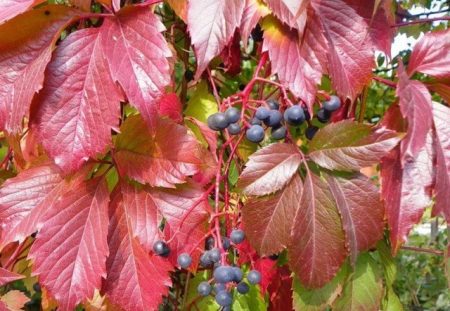
Wild ivy easily takes root at any time of the year, so young grape seedlings can be planted in spring and autumn. Grapes grow well in lighted areas, but also feel comfortable in shady areas, although in such conditions the leaves are formed small and light-colored. It gets along well in close proximity to tall bushes and trees. When planning a vineyard, one should take into account the fact that the shoots have tremendous growth power. Growing rapidly, they can "climb" over the fence and begin to conquer neighboring territory. Stems can braid other plants, household items. At the same time, when they appear on the ground, the branches quickly take root, which leads to the growth of a shrub.
For a year, shoots grow by 3-4 meters. Therefore, it is necessary to plan the area for growing grapes in advance.
The composition of the soil for wild grapes is not of particular importance. It may be sandstone or loam, poor in fertilizer or heavy, acidified soil. But still, the vine grows better on light, fertile land. Before planting seedlings, it is preferable to add compost or humus, ash, sand, superphosphate to the soil. In such loose, lightened soil, plants take root faster and start to grow. Grapes are planted in deep holes, the bottom of which is strewn with drainage. A powerful support is installed next to the seedling, to which the plant is tied immediately after planting.With vertical gardening, seedlings are placed a meter apart. The distance to the wall is 60 centimeters. After planting, the seedlings are watered, and then the earth is mulched.
Grape care
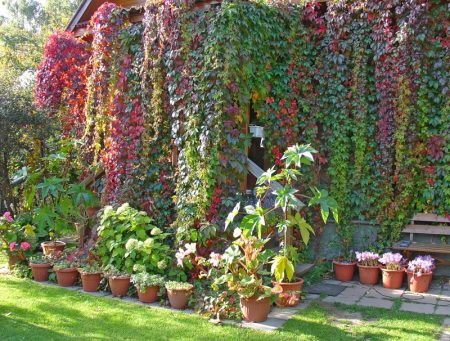
Girl's grapes do not require any special agricultural measures. All he needs for growth is regular watering, timely top dressing and annual pruning.
The plant consumes a lot of water to maintain the life of its dense green crown. However, she does not like overflows. During the summer, it is enough to water the vine by sprinkling method 3-4 times. Under the root, pour up to 10 liters of water. If the summer was rainy, then the bush does not need to be watered at all.
Watering is combined with top dressing. If the land was well fertilized in the year of planting, then the first fertilizer application takes place only in 2-3 years. Otherwise, fertilizing is arranged already in the year of planting the seedling. To build green mass, the plant requires a lot of nitrogen. It is introduced in the spring. You can limit yourself to organic matter or add urea, ammonium nitrate. 40-50 grams of nitrophoska is added to the soil. It is preferable to feed the grapes with complex mineral fertilizer, apply the drug Kemira Universal. In the fall, potash fertilizer is applied to better winter the plant. It is enough to sprinkle the near-stem section with ash or use kalimagnesia.
A powerful root system goes deep into the earth, extracting the necessary nutrients from its depths. Therefore, there is no need for additional and especially frequent top dressing for girl's grapes.
To give a neat appearance, the vine should be subjected to forming pruning. This type of pruning begins to be applied in the first year of life of grapes. Young branches are fixed to the support, and then they are sent in the right directions. In early spring, after snow melt, sanitary pruning is performed, while damaged, frostbite, old and excess branches, as well as those that grow in the wrong direction, are removed. Trimming can be done every two years. In this case, first, long shoots are shortened, and only then all running branches are cut.
When removing unnecessary branches, make a cut over the kidney, leaving no more than 5 millimeters above it. So the bush will look neat.
Most varieties of girl's grapes are frost-resistant, so they do not need to be covered for the winter. It will be enough to sprinkle the base of the shrub with fir spruce or straw. However, it is recommended that a young, recently planted vine be covered with a non-woven covering material in the cold period, for example, with a plastic film.
Breeding
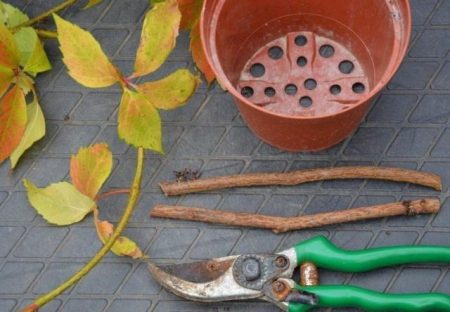
Girl's grapes can be propagated by cuttings, layering, seeds. The easiest way to get a new varietal plant, resorting to cuttings. Cuttings can be planted in spring or autumn. With autumn planting, cuttings are prepared in spring or early summer. As cuttings, small twigs (length 20 centimeters) are used, on which buds and leaflets should be. Before planting, the stalk is cleaned of antennae, stepsons and leaves. Chopped twigs are placed in a container of water and wait for the formation of roots. Then the cuttings are transplanted into the soil substrate, consisting of sand and earth. By autumn, rooted branches are planted in open ground. Each seedling is placed in the planting hole so that the root neck after falling asleep with earth is on the surface. The distance between future bushes should be at least 50 centimeters. Wild grapes grow well on any soil, but for better survival, it is rational to introduce organic matter and mineral fertilizers when digging, to lighten clay heavy soil with peat and drainage, and add humus to sandy soil. Planting of rooted seedlings is carried out in September.
Girl grapes can also be propagated by layering. To do this, in the spring, next to the plant, they dig a long shallow groove, where they then lay a two-year shoot and cover it with soil on top. The end of the branch should remain above the surface of the earth.So that the trenched branch does not jump out, it is fastened with metal staples. During the summer, roots are formed in places where the kidneys were. When this happens, the branch will need to be cut off from the mother plant and planted in another area.
The most unpopular way is seed propagation. This is due to the length of the process, since it takes several years to get an adult plant. Seeds selected in the summer are planted next spring. Planting material must be stratified before sowing, that is, for 1-1.5 months, seeds are kept in a moist sandy substrate at a temperature of +5 degrees. Then the seeds are sown in the nursery, where they will germinate in 30-35 days.
Diseases and Pests
Girl's grapes are very rarely affected by infections or harmful insects. Such diseases as spotted anthracnose or powdery mildew are alien to him, since the plant has an outstanding immunity. Of pests, aphids can sometimes be seen on leaflets. When it appears, the plant is watered with a soap-water solution, and then all areas are sprayed with biological preparations Fitoverm or Fufanon.
Use in landscape design
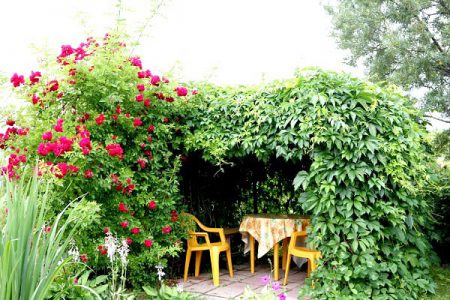
Girl's grapes are usually used as the main element of the decor of the garden. With the help of a long large creeper, you can not only decorate the front arch or porch of the house, but also mask the unsightly wall of the house, the rickety fence, the dilapidated arbor. The fast-growing shoots create a thick dark green carpet from the ideal form of leaves arranged symmetrically to each other. And although the appearance of the plant is far from original, because it does not give beautiful fragrant flowers, there is still a highlight in it: in the fall, when all other garden trees and shrubs drop foliage, the grape foliage is painted in all shades of red, yellow and green. Such a mixture of colors gives the garden a unique enchanting atmosphere. Together with a magnificent habit, unpretentiousness in leaving, frost resistance, independent attachment of shoots to surfaces, this grape surpasses all other types of lianoid plants.
Grapes can calmly grow near the road, as it is not afraid of pollution and bad air. He will not lose the attractiveness of foliage at the barn, construction site or garage. Liana can be allowed not only along sheer walls, but also with its help to form green arches and tunnels, decorate front gardens. Grapes can even be put on the ground - it looks great as a ground cover creeping plant. A dense green carpet will look great where flowering shrubs and flowers have failed. Moreover, this plant can even improve the structure of the soil if it is prone to erosion: numerous antennae interlock the soil, compact it. In addition, girl's grapes that are not demanding on soil quality will grow even on a rocky slope or sandstone, in the shade or in the sun. Shrubs and trees can be planted next to it - it does not create competition, getting along well with other representatives of the flora.
Advantages and disadvantages
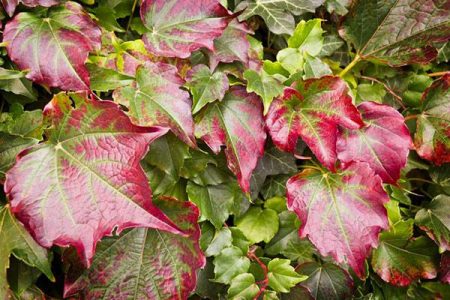
Wild grapes have many advantages in comparison with other vine-like plants. These include:
- decorativeness persists for a long time;
- unpretentiousness to the composition of the soil;
- frost resistance;
- rapid growth of shoots;
- persistent immunity to diseases and pests;
- good growth in the sunny area and in the shade;
- easy to breed;
- does not require fertilizer.
Despite the large track record of advantages, many gardeners still prefer to cultivate other lianoid plants in their plots. This is due to the fact that wild ivy grows very quickly, getting into the cracks with its numerous branches, causing the destruction of the foundation and roof. Without constant pruning, a liana can completely braid a house, windows and doors, envelop trees and fences.However, negative consequences can be avoided by timely cutting off rampant shoots.
Reviews
Michael
I really like wild grapes, as they decorate beautifully. But however, this is a difficult plant, because it grows very quickly, and you need to cut it very often, otherwise it will spread throughout the garden. If the fence or wall you want to decorate is small, it is better to plant a less aggressive plant. For example, some other grapes or lianoid bushes, less tall. Wild grapes are able to crush everything for themselves - neighboring trees, a roof, drainpipes. Long heavy vines are destructive, as their suction cups penetrate into various cracks, under the tiles and so on. Moreover, the severity of 10-meter branches, not every support can withstand. Girl's grapes are more suitable for large-scale composition, when you want to immediately quickly and a lot of greens. In small areas, it is better to plant other plants.
Anastasia
In the country, this grape has been growing for about 20 years. He completely wrapped his house in long vines. Many say that the liana spoils the roof and other elements of the building, but we have a brick house, and I assure you that the brick does not deteriorate for sure. I also know that powerful lianas reliably protect walls from dampness and drafts. Unpretentious, fast-growing and never sick grapes is not a particular hassle. All that will be needed is to cut the branches in time.
Conclusion
For this grape goes not too enviable reputation: too much effort needs to be given to the gardener to cope with such an aggressive plant. If you do not control its growth, then in a couple of years it will fill the entire garden space. However, this opinion is very controversial: girl’s grapes can be “tamed” by paying attention to forming pruning.




 Non-covering winter-hardy grape varieties for Moscow region
Non-covering winter-hardy grape varieties for Moscow region How to keep the vine in winter
How to keep the vine in winter When can I transfer grapes to another place in the fall
When can I transfer grapes to another place in the fall How to cover and prepare grapes for the winter in the suburbs
How to cover and prepare grapes for the winter in the suburbs